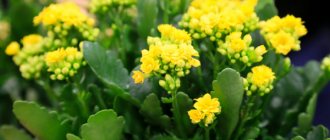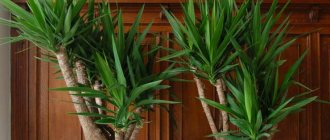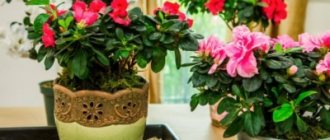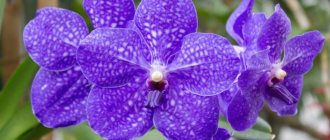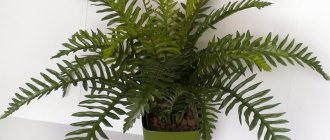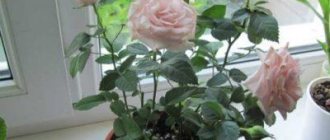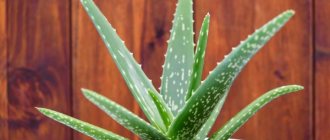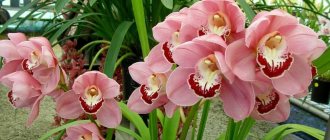Alocasia is an exotic ornamental foliage plant. A bright representative of the aroid family. Many varieties of this species differ from each other in color, shape, leaf size and dimensions. This plant appeared in indoor floriculture relatively recently - no more than 10 years ago, and some varieties are considered young and rare; flower growers dream of getting them into their collection. The plant has a bright appearance and is considered relatively unpretentious. it is often used for interior landscaping.
About the plant
Alocasia is a large, evergreen, herbaceous plant. As a rule, it has a developed aboveground stem, covered with scars - leaf traces of dead leaves. Young plants have a shortened stem. At the top of the stem there are several very large oval-arrow-shaped leaves.
Its leaves are thick, dense and almost leathery. Leaf blade with thick veins protruding on both sides; leaf petioles are long, succulent, with a long sheath. With good care, the plant develops 6-7 leaves, and the size of the leaf blades can reach 50-80 cm in length.
On a note !!!
The leaves have aqueous stomata-hydathodes, through which droplets of water are released in wet weather or when overwatered.
Sometimes it blooms in summer. The flowers are very small, collected in a spadix, equipped with a large light cover.
Alocasia flower
Alocasia is a fairly unpretentious plant that requires regular but simple care. It grows well in warm and humid microclimates. If you provide your tropical beauty with conditions close to natural, then she will delight you with her exotic beauty.
On a note !!!
If the leaves on an alocasia periodically turn yellow and disappear (one at a time, and not all at once), this is a normal process - a new one is already growing in place of the missing one.
How to properly care
Alocasia is suitable for indoor conditions. The plant can be placed on a windowsill, but the leaves must be protected from direct sunlight.
Landing
Immediately after purchasing the alocasia, you can plant it in a larger pot and add fertile soil. The best time for planting is spring. True, a plant purchased in winter can also be planted in a new pot. Adaptation will just be more painful.
Soil requirements
Alocasia needs slightly acidic and fertile soil that will allow moisture to flow well into the pan and dry quickly. The base is leaf or turf soil. Peat, sand, vermiculite, pieces of bark, chopped moss and a little humus are mixed into it.
Selection and arrangement of a pot
In alocasia, the roots grow not in breadth, but in length. The plant needs a deep but narrow pot. It would be better if it were ceramic. There should be a drainage hole at the bottom. A little expanded clay is poured into the pot for drainage, then the roots of the plant are sprinkled with the prepared soil mixture.
How to plant
The transshipment method is not suitable in this case
The plant, along with the earthen lump, is carefully removed from the pot, and then the roots are cleared of soil. This procedure is carried out to thoroughly examine the roots to see if there is any rot on them.
Before planting, the plant can be placed in water with a growth stimulator for 30 minutes. Then the alocasia is placed in a pot and covered with soil. The root collar should be above the soil surface.
Bloom
Alocasia blooms very rarely. An adult and fully formed plant produces an ear in spring or summer. Flowering lasts only 5-12 days. During this time, the plant manages to shed almost all its leaves. After flowering, alocasia regains its strength for a long time. If you cut off the flower stalk at the very beginning, the plant will not lose leaves.
Temperature and light
In the room where the alocasia is located, the air temperature should be 20-25 degrees Celsius. In winter, the thermometer can drop to 16 degrees above zero. At lower temperatures, the plant will begin to shed its leaves. A short stay in the cold can completely destroy this heat-loving crop. In summer, the plant gets enough sunlight. In autumn or spring in the evening it can be illuminated with a fluorescent lamp.
Air humidity
This tropical plant with large leaves loves a moist environment. Air humidity should be 70 percent.
Spraying
In hot weather, alocasia leaves should be sprayed 2-3 times a day. The water is sprayed in the form of a mist rather than droplets. In winter, this procedure can be performed less frequently.
Watering mode
Alocasia is watered abundantly, but so that the water does not stagnate in the pot for a long time, otherwise the roots will begin to rot. Watering is carried out every other day. The soil should always be moist, but not swampy.
Feeding and fertilizer
In the spring, when the period of active growth begins, the plant begins to be fed with nitrogen, phosphorus and potassium substances. A small amount of universal fertilizer is added to the water for irrigation twice a month until the fall.
Transfer
Once every 2-3 years, alocasia is transplanted into a larger pot. Drainage pebbles are placed at the bottom, and the rest of the container is filled with slightly acidic soil. Alocasia, along with a lump of earth, is removed from the old pot and transplanted into a new one.
This plant does not need any pruning. You can only trim off yellowed and dried leaves. True, they should turn yellow one at a time, and not all at once. A healthy plant sheds old leaves gradually, so it renews itself.
Alocasia: lighting
Alocasia is a light-loving plant, but it needs to be shaded from direct sunlight. The best location for the flower will be windows facing east. The flower will feel comfortable on the western side, but in the south its leaves will wither. In this case, as mentioned above, shading will be required.
But even if protected from bright sunlight, alocasia should not be severely oppressed. In this case, dark spots may appear on the leaves and there is a risk of the plant wilting. The color of the foliage may also change.
Some types of alocasia, in particular copper-red and Amazonian, require additional lighting in winter.
Varieties
Dragon Scale is the common name of the species. However, depending on the shade of the leaves, two varieties are distinguished.
Alocasia Silver Dragon
It is distinguished by silvery leaves and dark veins.
Alocasia Pink Dragon
A rare variety with dark leaves, light veins and pink stems.
It is interesting that the cost of these varieties in different stores and garden centers can vary dramatically, but the “pink dragon” always costs more.
Alocasia: watering and air humidity
Abundant in summer, the soil should never dry out. Water frequently with soft, settled water so that the soil in the pot is constantly moist (it is advisable to immediately drain the water from the pan). In winter, watering alocasia is moderate and very careful. For most species, overwatering leads to root rot.
Watering Alocasia
Alocasia loves high humidity. In hot summer weather it needs spraying. To create additional air humidity, you can place the pot with the plant on a tray with wet expanded clay or pebbles.
Alocasia: soil
Alocasia loves nutritious, loose and breathable soil with a slightly acidic alkaline environment (pH about 5.5). Mixtures of the following composition are well suited for planting:
- humus, leaf, turf soil, peat and sand in a ratio of 2:2:2:1;
- leafy, coniferous soil, peat, sand in the ratio 1:1:1:0.5;
- leaf, peat soil, crushed sphagnum, sand (2:1:0.5:1).
You can plant alocasia in a ready-made store-bought mixture intended for indoor plants.
In a good soil mixture, the plant exhibits all its decorative qualities. It grows and blooms well.
Alocasia: feeding
Fertilizer. In spring and summer, alocasia requires feeding every 2-3 weeks. It is best to use complex mineral fertilizer for indoor plants. Organic matter should be added carefully, as it contains a large amount of nitrogen, which can cause rotting of the flower, leaves and stem.
Fertilizers for alocasia
It is best to alternate feedings. For example, foliar feeding is applied first. Here liquid fertilizer is used for decorative deciduous plants. It is distributed over the leaves. After 14 days, the plant is watered with a solution containing mineral fertilizers. Mineral fertilizers can not be diluted in water, but used in dry form. Several granules, about 7-8 pieces, are placed on the ground after watering the plant. They gradually begin to melt and with each watering, along with water, they fertilize the soil.
Important!!!
Fertilizing should be used only in the recommended proportions, because an excess of fertilizers is no less dangerous for the plant than a deficiency.
When foliar feeding, not only ready-made liquid fertilizers are used, but also the HB-101 preparation, biological additives, and chelates.
Medicinal properties
Despite the fact that shamrock is poisonous, its medicinal properties are widely used in Chinese folk medicine. You just need to strictly follow the dosage so as not to harm the body.
Leaves treat pneumonia and tuberculosis. The stems help relieve stomach and toothache. The juice relieves pain and invigorates the body. Alocasia can suppress cancer cells.
It is not advisable to treat yourself in this way, so as not to get poisoned, but you are quite capable of placing a flowerpot near the patient’s bed when he has a cough or fever. Only it should be a large-rooted alocasia. This species has healing properties.
Be sure to have this amazing plant with unusually beautiful leaves at home. If you try a little, the weatherman will feel at home in your apartment, just like in wildlife.
Alocasia: transplant
The soil for alocasia must be nutritious. For good growth, you need a substrate that is well permeable to moisture and air and has a slightly acidic reaction (pH about 5.5).
Alocasia transplant
Replanted annually, usually in early spring, mature plants after two years, soil:
- 1 part leaf soil;
- 1 part coniferous;
- 1 part peat;
- 0.5 parts sand.
An earth mixture made up of sand, garden soil and greenhouse soil in equal parts is suitable.
On a note !!!
For large specimens, replanting can be replaced by transferring it to a pot of larger diameter. It is better to take tall pots. Good drainage is necessary.
Alocasia: reproduction
Alocasia can be propagated in different ways: by seeds, dividing the rhizome, suckers or daughter tubers, and stem cuttings.
Alocasia from seeds
Alocasia with variegated leaves cannot be propagated by seeds - variegated leaf characteristics are not expressed. Sow the seeds immediately after collection, shallowly in a light substrate (leaf or peat soil and sand). To ensure high humidity, cover the top with glass or film. Temperature 22-24°C and regular spraying. The seedlings are picked and then transplanted into small pots. Large leaves appear after a year.
Alocasia from seeds
Alocasia seeds
Alocasia offspring and daughter individuals
It is much easier to propagate alocasia by offspring or daughter tubers. When dividing the rhizome and preparing stem cuttings, do not forget to sprinkle the cut areas with charcoal. For rooting, the substrate is the same as for sowing seeds. You can cover the planted cuttings with film.
Reproduction of alocasia
Reproduction by cuttings
To do this, a bud is cut out from the stem of a large specimen along with the pulp adjacent to it. The surface of the cuts is sprinkled with crushed charcoal and placed in sand or a mixture of peat soil and sand, leaving the bud above the surface of the substrate.
Alocasia: pests
The most common pests of alocasia are aphids and spider mites. In addition, it is affected by mealybugs and scale insects. Dry air and high temperatures promote the appearance of pests. If pests are detected, if the infestation has not gone far, carefully wipe the leaves and stems with a soapy sponge. In case of severe damage, you can use Actellik solution (1-2 ml per liter of water) or another similar remedy.
Attention!!!
All organs of alocasia contain toxic substances, so you should be careful when caring for the plant, and wash your hands thoroughly after work. It is not suitable for landscaping children's institutions.
Alocasia, distinguished by its splendor and exotic beauty, is deservedly recognized as one of the most outstanding foliage and ornamental plants. Powerful specimens, reaching several meters in height, are a rich decoration of the interiors of public spaces: bright halls, foyers, rest rooms. Widely used in the creation of winter gardens and the design of artificial ponds and fountains. Only small young plants are suitable for keeping in rooms.
Prevention of various problems
Over time, the leaves inevitably turn yellow, but if green veins remain on them, and then they gradually dry out, this is a natural aging process. You just need to cut off such leaves. But if only the upper leaves turn yellow and dry out, this means that the air is too dry for the plant; you need to spray the alocasia with warm water more often.
If young leaves practically do not appear or grow small, this indicates that the plant requires feeding.
Alocasia Dragon is a beautiful indoor plant that will fit perfectly into any interior. The main thing is to follow all the rules for caring for it.
Possible difficulties
When growing alocasia, you should pay attention to the following difficulties that gardeners usually encounter when growing this plant:
- Alocasia has stopped growing. This situation arises for two reasons: either the plant needs replanting or is experiencing a deficiency of minerals. The solution here is very simple; the flower needs to be transplanted into a larger pot or, if the container is normal for the plant, fed.
Alocasia diseases - Alocasia leaves wither. This problem occurs when the soil is excessively waterlogged. It can also occur when the earthen lump is very dry. In this case, it is enough to adjust the watering. If, even after normal watering, the leaves continue to wither, it means that the soil in the pot is too dense. In this case, you should change the soil to a looser and more breathable one.
- Alocasia leaves have turned pale or changed color. This situation occurs with aging and dying leaves. In place of the old fallen leaves, after a certain period of time, new leaves grow. The drawing on the sheet may fade due to lack of light.
- The tips of the leaves dry out and turn black. The reason is lack of watering, low light, low air humidity.
- Dark spots have appeared on the leaves of Alocasia. There may be several reasons: drafts, hypothermia, too dry or vice versa, damp soil, overdose of fertilizers. Dark spots sometimes appear due to mechanical damage, waterlogging of the soil and excessive application of nitrogen fertilizers. This situation often leads to the occurrence of fungal and bacterial rot. In this case, the rotten place is treated with fungicides or the plant is transplanted into new soil.
- Rotting of the rhizome. This problem occurs when the room temperature is low, there are drafts, and the plant is flooded so that the soil does not have time to dry.
Alocasia: types and photos
Alocasia has about 70 varieties. It can grow up to two meters or more in height. It grows not only at home, but also in the wild. Used as a garden plant in countries with warm climates. Below are the most popular and famous varieties cultivated by gardeners around the world.
Amazonian alocasia (Alocasia amazonica)
A hybrid often referred to as A. Sanderiana. Stem up to 15 cm tall; petioles 40-60 cm long, pinkish-green with dark transverse strokes. The leaves are elongated, thyroid-shaped, with well-defined lobes, shallowly notched at the base and along the edge, 40-50 cm long, up to 20 cm wide, dark green, with 5-8 pairs of white lateral veins with white stripes along them.
Amazonian alocasia (Alocasia amazonica)
Peduncle 20 cm long, spadix whitish-pink in color up to 8-10 cm long. The spathe is whitish-greenish, up to 20 cm long, about 10 cm wide. When grown indoors, it practically does not bear fruit.
Alocasia sanderiana
It lives in tropical rainforests, at an altitude of 300-600 m above sea level in the Philippine Islands. Plants with short tuberous rhizomes. Leaves are up to 30-40 cm long and about 15 cm wide, elongated-arrow-shaped, with notched pinnate lobes, green, with a dark metallic sheen; lateral veins and edges are whitish.
Alocasia sanderiana
The petiole is brown-green, 25-60 cm long. The species is cultivated in warm greenhouses. Widely used in work on Alocasia hybridization.
Alocasia lou
Homeland: Borneo, Malaysia. Reaches 1 m in height, the trunk is quite short; forms underground root suckers. The leaves are on long petioles, oval or arrow-shaped, solid green or with white veins, the reverse side of the leaf is purple-violet. The petiole is attached in the center of the leaf. The plates are bluish-green with a characteristic metallic sheen, the specks and veins are silvery.
Alocasia lou
Alocasia cucullata
Originally from China, India, Sri Lanka. Plant height from 60 to 100cm - photo of the plant. The stem is 3-6 cm in diameter. Petioles are usually up to 30 cm long, rarely up to 50-80 cm. Leaves are large, up to 1 m long and 60-80 cm wide, dense, usually inclined, notched at the base of the plate, short pointed at the apex, shiny, bright to dark. green.
Alocasia cucullata
At the point where the petiole is attached, there is a characteristic swelling on the upper side of the leaf. Only powerful plants with a lot of leaves bloom. Peduncle up to 20-30 cm tall; the blanket is fleshy, up to 10-15 cm long, 3-8 cm wide; the cob is shorter than the spathe. The berries are hemispherical, medium-sized, 6-8 mm in diameter. It forms daughter tubers that are located close to the main one.
Alocasia macrorrhizos
Synonyms: Indian arum (A. indica (Lour.) Spach), Indian arum (Arum indicum Lour.), large-rooted arum (Arum macrorrhizon L.), Indian alocasia (Colocasia indica (Lour.) Kunth). Homeland: India, Sri Lanka, Malaysia. The plant is quite large in size - photo of the plant. The stems reach 2 m in height or more, the petioles are more than 1 m long. The leaf blade is ovate-heart-shaped with well-defined diverging lobes at the base of the blade, from 50 to 90 cm long and 40-80 cm wide.
Alocasia macrorrhizos
Peduncle up to 30 cm long, with a yellow-green spathe, 18-24 cm long, the spadix is equal to the length of the spathe. The berries are bright red, shiny, up to 1 cm in diameter. As an edible and medicinal plant (tubers - the so-called giant taro) are common in the tropics.
Photo of blooming large-rooted alocasia. The juice in the leaves is poisonous (contains hydrocyanic acid), but the plant is used in Chinese medicine. Preparations from the stem are used for pain in the stomach, intestines, toothache, and cholera. The crushed tuber is applied to various tumors. Preparations from the leaves and the whole plant are recommended in the treatment of pneumonia and tuberculosis.
Alocasia is light-loving, not afraid of sunburn, and tolerates shading. Undemanding in cultivation, can grow in rooms with central heating. Due to its large size, A. macrorhizos is more suitable for offices and winter gardens.
The form variegata (Alocasia macrorrhizos var. variegate) - photo - differs from the original form in variegated leaves with large white spots and smaller sizes.
Alocasia odora
Synonym: Arum odorum G. Lodd. It grows in the Himalayas, in the south of the Indochina Peninsula, on the island of Taiwan, the Philippines. A herbaceous plant with a thick, strong, short, almost tuberous rhizome. The shoots are thick, up to 1 m tall. The leaves are beautiful, leathery, fleshy on long petioles. The length of the leaves can reach 1 meter and the width is 60-80 cm.
Alocasia odora
Young leaves are thyroid-shaped, old ones are narrow ovate, almost linear, with an arrow-shaped base. The lower protruding parts of the plate are fused with the petiole. Inflorescence – spadix – photo. The flowers are sessile with a specific scent. The spathe is about 20 cm long, covers the cob, bluish-green in color - photo. It rarely blooms in the room.
Alocasia cuprea K. Koch
Homeland - o. Kalimantan. One of the most decorative and small alocasias. Stem up to 10 cm long. (often underground). Petioles are 20-30 cm long, the leaf blade is heart-ovate, vertically directed, up to 25-35 cm long, 14-17 cm wide, semi-leathery, copper-green above with a metallic sheen, intense purple below; the attachment of the petiole to the blade is thyroid (not to the edge of the blade, but at some distance from it); at the point of attachment on the upper side of the plate there is a characteristic swelling.
Alocasia copper-red
Peduncles are collected in groups of 2-3 and up to 10-15 cm long, dark purple. Bedspread up to 15 cm long and width up to 8 cm; the cob is always shorter than the spathe. Does not bear fruit in cultivation. The plant contains poisonous sap that causes skin irritation, so you must wear rubber gloves and wash your hands thoroughly after handling.
Alocasia reginula Black Velvet
Synonyms: A. hybrid (A. hybr. 'Black Velvet'). Homeland: Borneo. Stem up to 10 cm long. The petiole is up to 15-25 cm in length, the leaf blade is heart-shaped, ovate, velvety, black and burgundy above, the veins form a white pattern, the bottom is green up to 25-35 cm long and 20-25 cm wide.
Alocasia Black Velvet
Peduncle up to 10 cm in length, white-pink spathe, 7-9 cm long. with a pink cob. Often blooms indoors.
Alocasia reginula
This species differs from Black Velvet in that its leaves are glossy and dark green with an elongated tip. A. reginula and Black Velvet are light-loving and tolerate direct sunlight, but should be shaded during the daytime. They tolerate shading.
Alocasia reginula
Bloom
In all types of alocasia, the inflorescences are not particularly decorative. The main decoration of the plant is the leaves. And in this variety they are especially good.
When and how?
Alocasia rarely blooms, but usually occurs between July and September.
The inflorescence is shaped like an ear. It has a pale white-pink hue.
The inflorescence consists of many small flowers. On one side it is covered with a rather dense sheet of cover.
What do the fruits look like?
After flowering and pollination, fruits are formed, which are oblong berries of a rich reddish-brown color with seeds inside.
